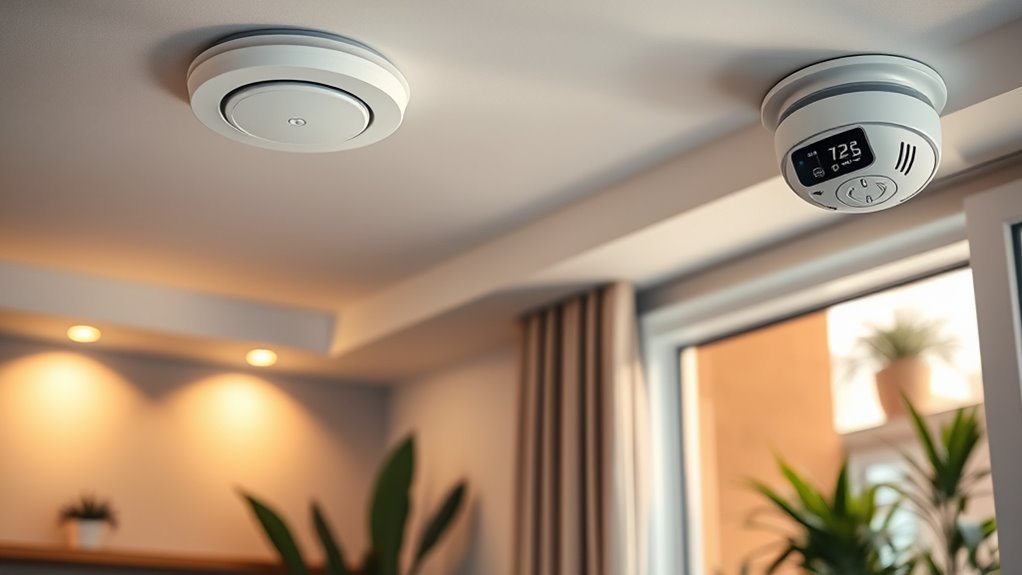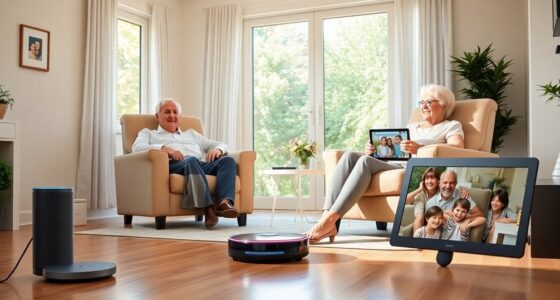Home safety sensors like fall detectors, smoke alarms, and carbon monoxide detectors help keep your home secure by alerting you to potential dangers early. They can notify you remotely through smart apps, allowing quick responses to emergencies. Integration with smart home systems makes managing these sensors easier and more reliable. Regular maintenance guarantees they stay effective. Keep your safety devices in top shape, and you’ll better protect your loved ones—more helpful tips await as you continue.
Key Takeaways
- Home safety sensors like fall detection and smoke alarms provide early warnings to prevent emergencies.
- Integrating sensors with smart home systems enables remote monitoring and instant alerts via apps.
- Regular maintenance, including testing and battery replacement, ensures sensor reliability and effectiveness.
- Smartphone apps facilitate real-time status updates, troubleshooting, and automated safety responses.
- Automated safety features, such as activating alarms or notifying emergency services, enhance overall home security.

Home safety sensors are essential tools that help protect your household by detecting potential dangers early. They’re designed to alert you to issues before they become emergencies, giving you peace of mind and a safer living environment. One of the key advantages of modern home safety sensors is their ability to integrate seamlessly with your smart home system. When your sensors are connected to a smart hub or app, you can monitor your home remotely, receive instant alerts, and even automate responses. For example, if a smoke alarm detects smoke or fire, your system can automatically turn on exhaust fans or notify emergency services. This level of smart home integration makes managing safety simpler and more effective.
To keep your sensors functioning reliably, sensor maintenance is vital. Regularly checking your sensors ensures they remain in good working order and can detect dangers accurately. Start by inspecting your smoke alarms and carbon monoxide detectors monthly, replacing batteries at least once a year or as needed. Dust and debris can interfere with sensor performance, so gently clean your sensors with a soft cloth or a vacuum attachment. For fall detection sensors, ensure they are securely mounted and haven’t shifted out of position, especially if you have pets or children around. Testing these sensors periodically by triggering their test functions confirms they’ll activate properly when needed. Additionally, understanding the importance of sensor reliability helps ensure your safety devices work effectively when it matters most.
Smart home integration also simplifies sensor maintenance. Many modern sensors come with smartphone apps that provide real-time status updates, battery alerts, and troubleshooting tips. Using these apps, you can easily monitor sensor health and receive reminders when maintenance is due, eliminating guesswork. Additionally, integrating sensors with your smart home system can enable automation; for example, if a sensor detects smoke, your system can turn on all the lights to guide you safely out of the house or unlock smart locks for quick egress. This interconnected setup guarantees that your safety measures are always active and responsive.
Frequently Asked Questions
How Do Fall Detection Sensors Differentiate Between Falls and Everyday Movements?
Fall detection sensors differentiate between falls and everyday movements through advanced motion detection and sensor calibration. They analyze rapid changes in velocity and angle that typical activities don’t produce. When sensors detect sudden, sharp movements with specific acceleration patterns, they trigger alerts. Proper calibration guarantees these sensors accurately distinguish between normal motion and falls, minimizing false alarms and providing reliable safety alerts when you need them most.
Can Smoke Alarms Be Integrated With Smart Home Systems for Remote Alerts?
Yes, smoke alarms can be integrated with smart home systems for remote alerting. By connecting your alarms to a smart home hub, you’ll receive instant notifications on your phone or other devices if smoke or fire is detected. This smart home integration allows you to monitor safety remotely, ensuring you stay informed even when you’re away, and can quickly take action to protect your home and loved ones.
What Is the Typical Lifespan of Home Safety Sensors Before Replacement?
Think of your sensors as vigilant guardians, standing watch like sentinels on a castle wall. Typically, they last 8 to 10 years before needing replacement. Regular sensor calibration guarantees they stay accurate, while battery life varies, often lasting 1 to 3 years. Keep an eye on signs of wear or malfunction, and replace them promptly to maintain your fortress’s safety and peace of mind.
Are There Sensors Designed Specifically for Outdoor Home Safety Monitoring?
Yes, there are sensors designed specifically for outdoor home safety monitoring. You can find outdoor security sensors that handle weather monitoring, such as rain, wind, and temperature changes, ensuring your property stays protected year-round. These sensors are built to withstand harsh conditions and provide reliable alerts for outdoor threats like intruders, fire, or weather damage. Incorporating outdoor-specific sensors enhances your overall safety and gives you peace of mind.
How Do Privacy Concerns Impact the Use of Home Safety Sensors?
Privacy concerns influence how you use home safety sensors by making you cautious about data encryption and user consent. You should guarantee that your devices encrypt data to protect your information from breaches. Additionally, you need to give clear user consent before installing sensors, understanding what data they collect. By staying informed and choosing secure options, you can enjoy safety benefits without compromising your privacy.
Conclusion
By installing home safety sensors, you protect your home, safeguard your loved ones, and enhance your peace of mind. Fall detection, smoke alarms, and other sensors work together to create a safer environment, alerting you to dangers before they escalate. With these devices, you prevent accidents, respond quickly to emergencies, and maintain a sense of security. Embrace these technologies to defend your home, guarantee your safety, and foster a worry-free living space.








